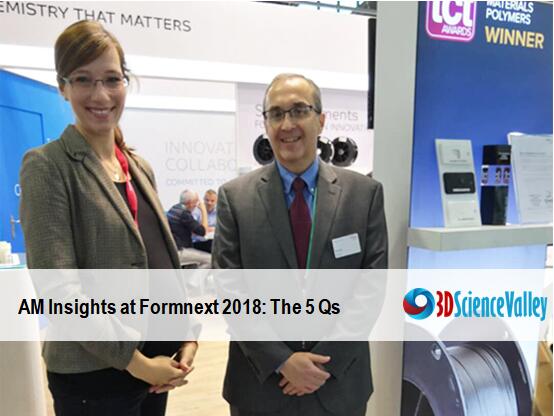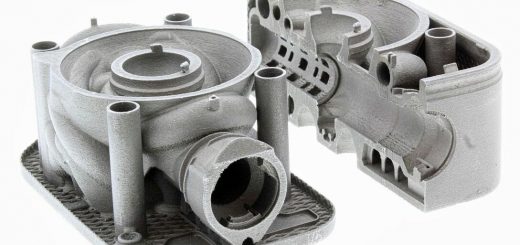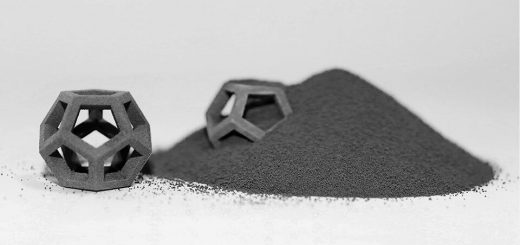AM Insights at formnext: 3D Science Valley interviewed with Keith Cox,SABIC Senior Business Manager Additive Manufacturing

Q1: What are SABIC’s highlights at Formnext?
SABIC has started in this space simply as a raw materials provider. So we have been active in additive manufacturing for about 10 years, providing materials to Stratasys primarily. The ULTEM materials or filaments Stratasys markets are from our portfolio of resins. Since then we have expanded into supplying our own materials. In 2017 we launched a variety of filaments specifically for use on the Stratasys platform. I would say the thing that is different this year is that we are expanding that to a broader range of open platform machines. You can see parts on display that have been printed on a variety of other open platform systems like Roboze, 3NTR, Apium. Our goal there is to get our materials out as broadly as possible to drive application development. We really see our focus being in driving to new application spaces and in driving to higher volume production. Our primary goal is to provide the materials which enable companies to do that.
In terms of new materials we are introducing on the filaments side, we have a new support material for ULTEM 9085 which is an easy release support. We are in the process of going through the final validation and commercialization stages with that product. It should be commercial in January and the feedback we are getting from our initial service bureau and equipment manufacturing partners is that it saves a lot of time in removing the support material from the part itself. So very good feedback on that.
The other thing we do have on display – and we tell everybody about this here – actually a product which we introduced last year which is a filament LEXAN™ EXL AMHI240F. It is a polycarbonate copolymer and it provides up to 4 times the impact strength of a standard polycarbonate. This year it was recognized by TCT as the “Material Innovation of the Year”. The importance of that is multifaceted, but when we look for validation for the work we are doing – the judges who are part of that [award] are industry experts and long-term players in this industry. For them to recognize it, is validation for our underlying assumption that what this industry needs is differentiated material performance. That is what we are really trying to drive.
Along those lines we also have a variety of new filaments that will be commercialized really soon, things like an FST – flames smoke and toxicity product for the aerospace industry that’s made from polycarbonate as opposed to ULTEM, so lower temperature but it still has the same flammability performances as a 9085 type product.
On the SLS space we have what we believe is very unique technology to be able to produce amorphous parts on SLS equipment, which is traditionally using semi-crystal materials. The first material we are looking at is polycarbonate. We have a variety of parts on display that are fully amorphous with 96%+ density polycarbonate parts. It is 100% recyclable. You can take material that has been through the SLS process, just take it and put right back in. You don’t need to add refresh material. We have demonstrated that through 4 cycles to this point which is significantly different from any other material that is out there for SLS. In addition, the technology we use to be able to print those amorphous parts out of polycarbonate is translatable to other base resins, other materials. We have got proof-of-concept parts out of polyurethane which are also fully amorphous laser sintered parts.
We are excited to move those types of technologies forward. That broadens the material portfolio and it broadens the application spaces that are attainable to designers. We think that ultimately that’s what drives the growth of the industry.
The other area we are very active in is large format printing. Such asfor Local Motors’ Strati car and recently their Olli vehicle, the self-driving electric shuttle. And with a company called CNC-Barcenas we have printed a ventilation grill for ocean vessels, quite a large grill. It takes weight out of the process and time – what used to have a lead time of a few weeks they can print now in a few hours. Each ship has 40 or more of these ventilation grills, but they are all different sizes. So it fits very well with the additive manufacturing scope.
The biggest benefit for large part additive manufacturing, we believe, is in tooling. There is a wide range of tooling applications for thermal forming. You need a variety of different base resins as the carrier but they need to be reinforced materials. So we start with those as a base resin and then we add a filler that could be glass fibre, carbon fibre, could be milled glass or any other type of material with different suitability for different applications. We have examples of thermal forming tools out here for an aircraft interior panel.
Q2: How has your 3D printing related business been faring this year compared to 2017?
I won’t be able to answer specifically for SABIC, but for any large materials company additive manufacturing is still a small part of our business. This is when you compare additive manufacturing with injection moulding for example, where most of these companies have their history. It is still very small but growing. We see the value in additive manufacturing, the uniqueness of these materials and the ability to design and produce parts that cannot be done by other technologies. Still very positive on where the industry is headed.
Q3: What are the current challenges SABIC is focusing on?
To me it really comes down to the availability of the right products for the right applications. Even if you look at any of the technologies on the plastics side there is still a very small number of materials available today and what we focus on is allowing new application spaces to develop as you move into different industries. Different industries and their regulatory requirements ask for different products. A lot of energy goes into bringing differentiated materials and that could be anything. Aerospace is an example of that and healthcare products have a different set of regulations thanlet’s say railway. As additive manufacturing expands and finds new areas of application our role is to provide the right products [materials] that can meet those requirements.
Q4: When walking away from the highly regulated industries – and it is being talked about in AM that the user industries are broadening – into very different maybe more mass manufacturing oriented applications such as household appliances or generally consumer goods, is the background large material companies such as SABIC have in let’s say injection moulding transferrable in some way to the additive manufacturing sphere? Do you benefit there in a way?
When you look at companies like SABIC, large materials companies, what is unique is that we have played in these markets for decades. We have people in our organization who can talk to you in detail about aerospace appliances, people focused solely on healthcare, people in consumer electronics and automotive. So I think it is that knowledge base and understanding of the requirements of each of those industries which are unique in terms of material performance, specification and quality. We have all of those capabilities built within our business because we have been working with these industries before outside of additive manufacturing.
This is reflected also in our additive products. Our filaments for example are of very high quality because we know it relates directly to the quality of the part you can produce. It is these kinds of things that are transferrable to the additive industry. Something that had largely been missing when this all was still more of prototyping, but it is changing and materials companies have a role to play in that regard. We do have a different perspective on what it will take for this technology to be broadly adopted.
Q5: What is your expectation for the coming 5 years in this industry?
We would agree with the Wholers report forecast. We expect the industry will continue to enjoy double digit growth. The uncertainty is where that growth comes from. There is an aspirational goal to become a production technology. Will that happen in 5, 10 or 20 years? I don’t know. I think you can find pockets of it and you can point at such pockets already today. But I think mass customization and smaller production runs are going to remain the biggest focus for additive in the short term. To get to full scale mass production, there are still a lot of hurdles to overcome. You can find use cases today where that does work but I don’t think that is the standard. If you look around the show today you find a lot smaller or unique niche applications and I think it will continue to develop that way for a period of time – if 5 years, I can’t say. The industry is settling in, becoming comfortable with this kind of growth trajectory. However, growth will continue quite rapidly over the next five years.




Recent Comments